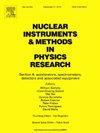全新极轻吸管管探测器,无纺布石墨织物
IF 1.4
3区 物理与天体物理
Q3 INSTRUMENTS & INSTRUMENTATION
Nuclear Instruments & Methods in Physics Research Section A-accelerators Spectrometers Detectors and Associated Equipment
Pub Date : 2025-07-25
DOI:10.1016/j.nima.2025.170854
引用次数: 0
摘要
J-PARC的彗星实验旨在寻找轻子味的介子到电子转换过程,其分支比灵敏度为10−17。该过程的预期信号为单色的105mev单电子。由于探测精度主要受到多重散射的限制,因此为了区分这种低能量信号,探测器的材料预算是必不可少的。为了实现所需的低材料预算,采用超声焊接技术开发了一种真空兼容的超薄壁秸秆跟踪器,该跟踪器由20 μ m厚的聚酯薄膜秸秆和70 nm铝阴极组成。VCI2016报告了这一点,VCI2019报告了探测器的检测效率和固有空间分辨率等性能。平行生产20µm秸秆,进一步稀释秸秆,即。12µm厚,用于COMET升级(COMET Phase-II)。12µm吸管的研发细节已在VCI2022中报道。在开发12µm吸管的过程中,很明显,使用目前基于超声波焊接的吸管制造方法,从根本上很难使其更薄。我们的研发表明,极限在10-12 μ m左右。然后,用石墨无纺布开发了全新的极轻吸管。这是通过与纳米技术纺织科学的合作实现的。本文将详细介绍全新的无纺布石墨吸管的研发,以及COMET实验中吸管管跟踪器的建设现状。本文章由计算机程序翻译,如有差异,请以英文原文为准。
Brand-new extremely light straw-tube detector with a nonwoven graphite-textile
The COMET experiment at J-PARC aims to search for a lepton-flavour violating process of muon to electron conversion, with a branching-ratio sensitivity of . The expected signal of this process is monochromatic 105 MeV single electron. To distinguish such a low energy signal, a material budget of detector is essential since the detection accuracy is primarily limited by multiple scattering. To realise the required LOW material budget, a vacuum-compatible ultra-thin-wall straw tracker, 20 µm-thick Mylar straw with 70 nm Al cathode, has been developed employing ultrasonic-welding technique. This was reported in VCI2016, and the detector performances such as detection efficiency and intrinsic spacial resolutions were reported in VCI2019. In parallel to 20 µm straw production, further thinner straw, ie. 12 µm-thick, was developed for the COMET upgrade (COMET Phase-II). Details of R&D on 12 µm straw were reported in VCI2022.
In the process of developing the 12 µm straw, it became clear that it would be fundamentally difficult to make it any thinner using the current straw manufacturing method based on ultrasonic welding. Our R&D showed that the limit is around 10–12 µm. Then, the brand-new extremely light straw was developed with a nonwoven graphite-textile. This was enabled by a collaboration with the nano-tech textile science.
In this article, detailed R&D of the brand-new nonwoven graphite straw will be presented, in addition to the current status of straw-tube tracker construction for the COMET experiment.
求助全文
通过发布文献求助,成功后即可免费获取论文全文。
去求助
来源期刊
CiteScore
3.20
自引率
21.40%
发文量
787
审稿时长
1 months
期刊介绍:
Section A of Nuclear Instruments and Methods in Physics Research publishes papers on design, manufacturing and performance of scientific instruments with an emphasis on large scale facilities. This includes the development of particle accelerators, ion sources, beam transport systems and target arrangements as well as the use of secondary phenomena such as synchrotron radiation and free electron lasers. It also includes all types of instrumentation for the detection and spectrometry of radiations from high energy processes and nuclear decays, as well as instrumentation for experiments at nuclear reactors. Specialized electronics for nuclear and other types of spectrometry as well as computerization of measurements and control systems in this area also find their place in the A section.
Theoretical as well as experimental papers are accepted.

 求助内容:
求助内容: 应助结果提醒方式:
应助结果提醒方式:


